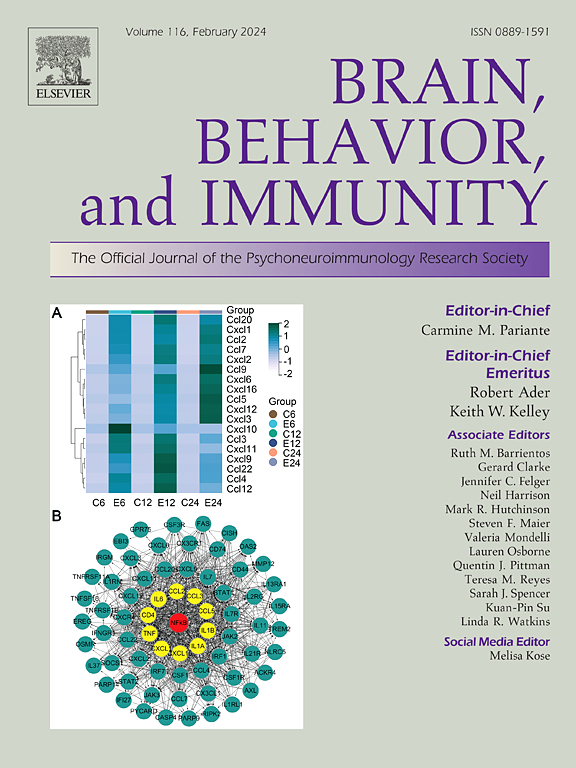干扰素-α对细胞合成代谢和分解代谢过程的急性影响与干扰素-α治疗丙型肝炎期间疲劳的产生有关:一项初步研究。
IF 7.6
2区 医学
Q1 IMMUNOLOGY
引用次数: 0
摘要
导言:干扰素-α(IFN-α)是抗病毒免疫反应的关键介质,用于治疗丙型肝炎病毒(HCV)感染。虽然 IFN-α 在临床上很有效,但它经常会诱发功能性的情绪和动力受损症状,尤其是疲劳。与通常在治疗数周后出现的情绪损害不同,疲劳往往出现和发展迅速,通常在首次注射 IFN-α 后数小时内出现。尽管疲劳是 IFN-α 和其他免疫疗法过程中功能损害的一个主要来源,但人们对其背后的生物机制仍然知之甚少。在此,我们旨在确定可预测日后疲劳发展的 IFN-α 急性免疫反应特征:在这项探索性研究中,我们对开始接受 IFN-α 和利巴韦林治疗的 27 名 HCV 患者的纵向样本进行了全血转录组学分析。我们在基线和首次服用 IFN-α 后 4½ 小时采集了血样,并使用 Affymetrix 人类基因 1.1 ST 阵列条采集了转录组数据。使用 Partek Genomics Suite V6.6 对基因表达数据的可视化和质量控制进行了评估,并使用 STRING 和 Ingenuity Pathway Analysis (IPA) 对蛋白质-蛋白质相互作用网络进行了评估。采用疲劳视觉模拟量表(fVAS)记录基线、治疗开始后4个半小时和4周的疲劳症状:结果:IFN-α 与 526 个转录本的上调和 228 个基因的下调相关,表明在注射后 4 个半小时内,全血中的转录本组反应迅速。93个基因与疲劳度的变化呈明显的正相关,基因表达的变化是从基线到4.5小时的测量,疲劳度的增加是从基线到第4周的fVAS评估。我们发现了一个主要由细胞质核糖体单位和泛素蛋白组成的新型网络,它们与调节 mTOR 信号转导有关,该网络与开始 IFN-α 治疗 4 周后疲劳的发生有关(p = 0.0078):我们的研究结果表明,IFN-α对这种合成代谢/代谢网络的急性激活可能会导致疲劳,这与癌症相关疲劳中发现的证据相似。为了证实这些观察结果的探索性质,有必要进行进一步调查。本文章由计算机程序翻译,如有差异,请以英文原文为准。
Acute effects of interferon-alpha on cellular anabolic and catabolic processes are associated with the development of fatigue during Interferon-alpha-based therapy for Hepatitis-C: A preliminary study
Introduction
Interferon-alpha (IFN-α) is a key mediator of antiviral immune responses used to treat Hepatitis-C virus (HCV) infection. Though clinically effective, IFN-α frequently induces functionally impairing mood and motivation symptoms, particularly fatigue. Unlike mood impairment, which typically emerges after weeks of treatment, fatigue tends to emerge and evolve rapidly, typically within hours of the first IFN-α injection. Despite being a major source of functional impairment during IFN-α and other immune-based therapies, the biological mechanisms underlying fatigue remain poorly understood. Here, we aimed to identify acute immune-response signatures to IFN-α that could predict the later development of fatigue.
Methods
In this exploratory study, we analyzed whole blood transcriptomics in a longitudinal sample of 27 HCV patients initiating IFN-α and Ribavirin therapy. Blood samples were obtained at baseline and 4½ hours after the first IFN-α dose and transcriptomic data was obtained using Affymetrix Human Gene 1.1 ST Array Strips. Gene expression data visualization and quality control were assessed using Partek Genomics Suite V6.6 and protein–protein interaction networks using STRING and Ingenuity Pathway Analysis (IPA). A Fatigue Visual Analogue Scale (fVAS) was utilized to record fatigue symptoms at baseline, 4½ hours and 4 weeks after initiation of treatment.
Results
IFN-α was associated with an upregulation of 526 transcripts and a downregulation of 228 genes, indicating a rapid transcriptomic response in whole blood within 4½ hours of injection. 93 genes were significantly positively correlated with changes in fatigue, with gene expression changes measured from baseline to 4.5 h and increases in fatigue assessed from baseline to week 4 on the fVAS. We identified a novel network of predominantly cytosolic ribosomal units and ubiquitin proteins implicated in modulating mTOR signaling that was associated with the development of fatigue 4 weeks after initiation of IFN-α treatment (p = 0.0078).
Conclusion
Our findings suggest that acute activation of this anabolic/catabolic network by IFN-α may predispose to the experience of fatigue similar to evidence found in cancer-related fatigue. Further investigation is warranted to confirm the exploratory nature of these observations.
求助全文
通过发布文献求助,成功后即可免费获取论文全文。
去求助
来源期刊
CiteScore
29.60
自引率
2.00%
发文量
290
审稿时长
28 days
期刊介绍:
Established in 1987, Brain, Behavior, and Immunity proudly serves as the official journal of the Psychoneuroimmunology Research Society (PNIRS). This pioneering journal is dedicated to publishing peer-reviewed basic, experimental, and clinical studies that explore the intricate interactions among behavioral, neural, endocrine, and immune systems in both humans and animals.
As an international and interdisciplinary platform, Brain, Behavior, and Immunity focuses on original research spanning neuroscience, immunology, integrative physiology, behavioral biology, psychiatry, psychology, and clinical medicine. The journal is inclusive of research conducted at various levels, including molecular, cellular, social, and whole organism perspectives. With a commitment to efficiency, the journal facilitates online submission and review, ensuring timely publication of experimental results. Manuscripts typically undergo peer review and are returned to authors within 30 days of submission. It's worth noting that Brain, Behavior, and Immunity, published eight times a year, does not impose submission fees or page charges, fostering an open and accessible platform for scientific discourse.

 求助内容:
求助内容: 应助结果提醒方式:
应助结果提醒方式:


